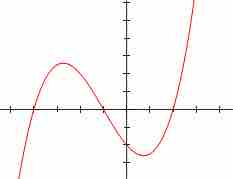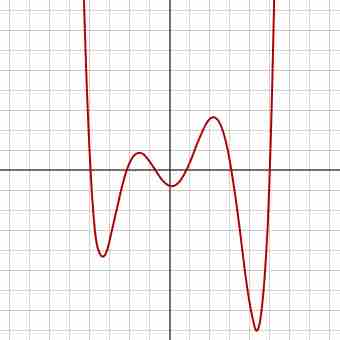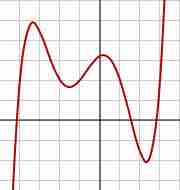Polynomials appear in a wide variety of areas of mathematics and science. To better study and understand a polynomial, we sometimes like to draw its graph.
Visible Properties of a Polynomial
A typical graph of a polynomial function of degree 3 is the following:

A polynomial of degree $3$
Graph of a polynomial function with equation
Zeros
If we factorize the above function we see that
Behavior Near Infinity
As
In general, polynomials will show the same behavior as their highest-degree term. Functions of even degree will go to positive or negative infinity (depending on the sign of the coefficient of the highest-degree term) if
How to Sketch a Graph
Conversely, if we know the zeros of a polynomial, and we know how it behaves near infinity, we can already make a nice sketch of the graph. We can exactly draw the points
So in our example, we start with a negative sign until we reach
With this procedure, we can draw a reasonable sketch of our graph, by only looking at the sign of the function and drawing a smooth line with the same sign! However, we can do better. For example, the number of times a function reaches a local minimum or maximum (i.e. a point where the graph descends and then starts to ascend again, or vice versa) is finite. In particular, it is smaller than the degree of the given polynomial. So if you draw a graph, make sure you draw no more local extremum points than you should.
Easy Points to Draw
Another easy point to draw is the intersection with the
Examples
- The graph of the zero polynomial
$f(x)=0$ is the$x$ -axis, since all real numbers are zeros. - The graph of a degree
$0$ polynomial$f(x)=a_0$ , where$a_0 \not = 0$ , is a horizontal line with$y$ -intercept$a_0$ . - The graph of a degree 1 polynomial (or linear function)
$f(x) = a_0 + a_1x$ , where$a_1 \not = 0$ , is a straight line with$y$ -intercept$a_0$ and slope$a_1$ . - The graph of a degree 2 polynomial
$f(x) = a_0 + a_1x + a_2x^2$ , where$a_2 \neq 0$ is a parabola. - The graph of a degree 3 polynomial
$f(x) = a_0 + a_1x + a_2x^2 + a_3x^3$ , where$a_3 \neq 0$ , is a cubic curve. - The graph of any polynomial with degree 2 or greater
$f(x) = a_0 + a_1x + a_2x^2 + ... + a_nx^n$ , where$a_n \neq 0$ and$n \geq 2$ is a continuous non-linear curve. - The graph of a non-constant (univariate) polynomial always tends to infinity when the variable increases indefinitely (in absolute value).
Examples
Below are some examples of graphs of functions.

A polynomial of degree 6
A polynomial of degree 6. Its constant term is between -1 and 0. Its highest-degree coefficient is positive. It has exactly 6 zeroes and 5 local extrema.

A polynomial of degree 5
A polynomial of degree 5. Its constant term is between 3 and 4. Its highest-degree coefficient is positive. It has 3 real zeros (and two complex ones). However, it has 4 local extrema.